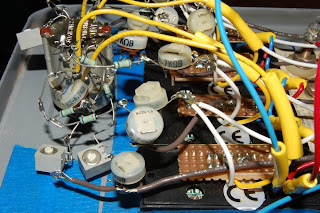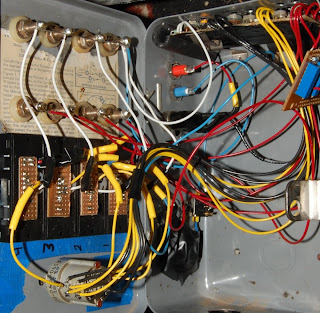Things are looking good for my diode test rig, only 1.5 years in the making. To recap, it's a comparative machine that tests four at once. I was having a hell of a time calibrating it (across 4 parallel voltage dividing resistances) so I added a bank of MOSFET transistors to decouple each branch from the power supply, and eliminate the pesky crosstalk from wreaking havoc on my calibration process. But, before I go into that, here's photo-documentation of the earliest revisions:

In the event it hasn't occured to you by looking at that pic, this phase was a HUGE pain in the ass to calibrate. It entailed flipping the lid (which required mental inversion of position, since everything you see there is actually mounted to the lid) and gingerly turning the screwdriver slotted into a pot that is suspended by wires. Simply locating the correct pot for display and range was bad enough, but this mock-up proved the theory enough to pave the way to revision 2:
 This was a huge step forward, all calibration being routed into the base of the unit allowing for adjustments with the test fixture closed and operating. Now, being able to physically engage in the act of calibration, I could come to the conclusion that from an electrical standpoint calibration was impossible.
This was a huge step forward, all calibration being routed into the base of the unit allowing for adjustments with the test fixture closed and operating. Now, being able to physically engage in the act of calibration, I could come to the conclusion that from an electrical standpoint calibration was impossible.In a nutshell, here's what's going on: An external variable voltage is fed through 4 identical load resistances which in turn each feed a diode in a conductive position; from the legs of the DUT is a three tier resistance ladder comprised of precision metal film resistors and trimpots (my basis of calibration) for each step, a millivolt meter is fed from taps along this ladder.
My theory is that the variable internal resistance of the diodes under test was large enough to throw the four parallel loads out of balance, making calibration impossible. So, the easiest (attempt at a) fix I could come up with was to slap some buffers on the variable voltage feed and hope to eliminate or at least reduce to an immeasurable level any cross talk between the test channels.
My first attempt at this was during a beer fuelled ElectronFeed meet, in which I electrically placed the MOSFET buffers feeding the DUT directly, on the wrong side of the load. This resulted in my polarity protection 1N4001 on the 12 volt meter feed acting as a fuse.
After sorting that out the meters wouldn't hold a steady measurement. Fearing them cooked, I disentangled one from the device, only to discover it worked fine. So now, with the inclusion of the buffers in a logical manner my metering has gone to shit. I'm a rat's whisker from gutting the entire thing and starting fresh when on a whim I disconnect the meter supply from common ground. Worked like a charm. So now, since I haven't any DC to DC converters laying about, I'll dedicate three power supplies to this thing. The variable bench supply (now only a reference thanks to the buffers), a 12 volt supply for the buffers sharing ground with the variable, and a 12 volt floating supply for the meters.
This weekend I hope to plunge a larger hole in the case to support the multipin PSU buss so I can escape the web of supply wires in order to... begin calibration.
All in the name of ring modulation.
No comments:
Post a Comment